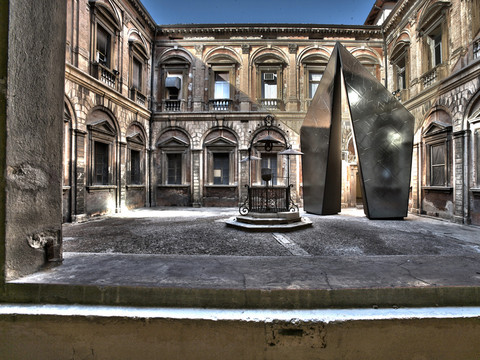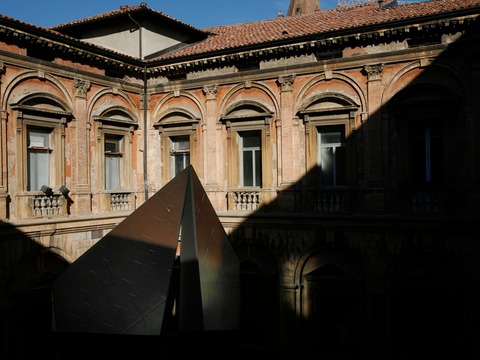Pinnacle Daniel Libeskind with Casalgrande Padana.
Bologna Water Design 2013
January 07, 2014
Pinnacle is a preview of a new system design for Casalgrande Padana. The installation focuses on the revelation between cladding surface, three-dimensional shapes and space. Which role is played by the selected material that is ceramic, and what technological potential do you have recognized that we need?
Well, I think Casalgrande has created fantastic technology using an ancient material, ceramic, but in a really 21st century way. And to give it a sense of characteristics which are new, which are reflectivity, which are the tactile quality, which are the sheen and the three-dimensional itself. So I think, to me, it has a fantastic potential as a building material for not just small-scale things, but like the pinnacles of large-scale architectural works.
But Pinnacle interprets concept as verticality, as you say, perception and light reflection. What effects do you aim to have on your observers, and what was the inspiration for the work of art?
Well, inspiration is really everywhere. It’s about light. It’s about water. It’s about desire. It’s a reflection. It’s about the sky. It’s about the horizon. When you look at the surface, you can see the history, really, of a structure. You can also see all the geometries, fractal geometries, and a completely new sense of creating complexity with very, very simple forms. I think that really creates really a pinnacle of a new sense of moving forward with materials.
And what about the dialogue with Italian production represented by the client, this well-known Italian manufacturer, Casalgrande Padana?
Working with Casalgrande Padana is a fantastic thing, because this company has great knowledge, great expertise, but also is interested in research and development of these classical materials into a new state of ecological reality. So the self-cleaning properties, the properties of sustainable building are part of developing really a new sense of what ceramic material can do for our buildings.
Do these slabs have also the property of cleaning?
Self-cleaning, yes. They are self-cleaning, so the pollution in the air is cleaned through the tiles. So the tile is not any longer the old style, but really a new characteristic that really helps the cities survive in a way that is elegant.
So the new quality of life reflection added to sustainability?
Exactly. You can really see that this is not a repeat of something, but really a very new sense of space as well.
Well, I know that in Italy you have also designed CityLife in Milan, also choosing ceramics as building materials. How does ceramic integrate Milan urban culture and your sign, your style in architecture?
Well, first of all, ceramics is a very human material that has a human scale of tactility. It is not just like a raw concrete or metal. It’s not an abstract material. It’s a material that comes from the earth, and has a certain quality of generosity in terms of generating an aura of the space. So I think it’s very much a material that is both traditional and new and avant-garde, and Milan really represents both of those pulls. It’s an ancient city with incredible traditions itself, and at the same time, of course, it is one of the most progressive, interesting, avant-garde cities in the world. So yes, it is the right material for it.
Yes.
So you think culture, Italian culture has an influence on your work?
Oh, well, I think there is no good – it is not possible to be a good architectural designer without it playing a fundamental, essential role because, where did the design originate? Where did ideas of design come from? They came from here, over many, many centuries and many millennia. And I think it’s not a coincidence that Italy has always been a cultural sort of gravity of design.
Thank you, Mr. Libeskind.
Thank you. It’s a pleasure.
Next time in Italy.
Absolutely. Thank you very much.
back to top print
Post-it
ISSN 2239-6063
edited by
Alfonso Acocella
redazione materialdesign@unife.it




